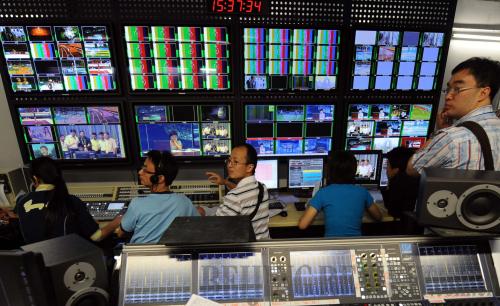|
 |
|
A GIANT UNIT: Technicians work in a news broadcast studio of the China Central Television (CCTV) on July 30, 2008. CCTV is one of the biggest public institutions in China (LI WEN) |
After more than three decades of reform, China has finally decided to reshape public institutions to improve social services.
In March, the Chinese Government implemented a program to reform public institutions nationwide by type. On June 2, a detailed timetable was announced at a conference in Beijing, inaugurating one of the country's toughest reforms in history.
Official statistics show China has 1.26 million public institutions with more than 40 million staff members and retirees. Among all the public institutions, there are 952,000 practicing independent accounting. More than 70 percent of the country's scientific research personnel and 95 percent of teachers and medical workers are working in public institutions. Expenditures on these institutions account for more than 30 percent of government revenues.
Premier Wen Jiabao said in his government work report to this year's session of the National People's Congress, China's top legislature, the reform of public institutions aims at stopping them from performing government and business functions, as well as separating supervision from day-to-day operations and for-profit institutions from non-profit ones.
According to the announced timetable, the government will categorize public institutions in accordance with their functions through 2015. By 2020, a new system for the management and operation of public institutions will be established.
Obscure functions
With the country's policy of reform and opening up going deeper, problems of the decades-old system for managing public institutions have become increasingly evident.
Many public institutions are blamed for overstaffing, inefficiency and slack management. "They felt it difficult to adapt to the needs of the market economy and some of them have become obstacles to coordinated economic and social development," said Wang Yukai, a professor at the Chinese Academy of Governance.
According to Wang, China's public institutions fall into three categories. Those in the first category perform some administrative functions or serve government departments, mainly engaged in supervision, quality inspection, authorization or logistic services. The second category consists of institutions serving the market and enterprises through consultation and coordination services. Institutions in the third category, which represent the majority, are engaged in social services.
"The value of public institutions lies in providing sound services," Wang said.
But some public institutions have acted like government departments or for-profit businesses, instead of performing their duties to effectively provide services. For example, some institutions with administrative powers impose unnecessary fines.
Besides, outdated organizational and management systems in some institutions have resulted in low efficiency and a waste of public resources.
"There is a widening gap between the performance of public institutions and the demand of the general public," Wang said. "Reforming public institutions holds the key to improving the quality and efficiency of public services."
Incremental reforms
Since 1985, China has been attempting to reform its public institutions, but the progress was slow and there was regression in some areas.
For example, Shanxi, Zhejiang and Guangdong provinces and Shanghai and Chongqing municipalities were chosen to pilot the pension reform for public institution employees in 2008. But so far none of the five provinces and municipalities has really started the reform.
In 2009 Guangdong planned to carry out an ambitious reform of higher learning institutions. But even before implementation began, the reform program met strong opposition from the university teaching staff and was set aside.
"Except lacking the motivation to reform, many public institutions and their staff resist changes due to entrenched interests," said Huang Hengxue, a professor at the School of Government of Peking University.
This time, the Central Government has determined to totally change the situation.
| 